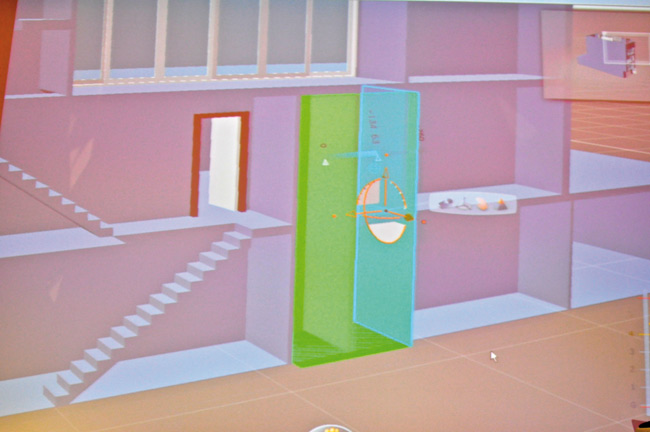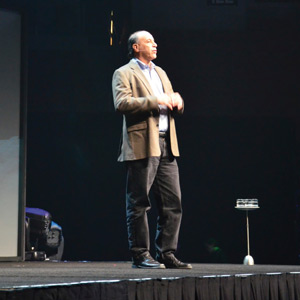The end of November saw the annual migration of CAD fans to Las Vegas for Autodesk’s huge University event. As usual, AEC magazine was there in force to see the latest design technology, writes Martyn Day.
There are very few cities even in America with the necessary infrastructure to host Autodesk University (AU). In the past attendance has been as high as 12,000 but with the recession and the availability of many of the main stage presentations now online, attendance has dropped to around 7,000. That is still a lot of people to fit in a room. I am told that Autodesk University had over 40,000 people sign up and it is available all year for those that are interested (au.autodesk.com)
The show is a week-long mix of general presentations, training classes, industry sessions and meetings, not to mention the lunches, cocktail evenings and parties. It is almost an Olympic endurance sport.
Autodesk has settled into yearly releases of its products, usually around March, with mid-year (October) additional functionality for customers on subscription. AU falls at the end of the year and so while some new technology is on view, future technology is often disguised in the presentations, obliquely referenced or not mentioned at all. It is always a good game to spot never-been-seen products.
Of course this is also limited, as Autodesk Labs online is mushrooming with technology demonstrations of future products. This year was no different and Autodesk Labs had some new technology previews to share with interested customers, but more on those later.
The cloud
There has been a lot of talk about cloud computing and its future impact on how we will access design software in the future. At the moment, software is bought and installed on a local PC. In the future software will be hosted on powerful servers and will be accessed over the Internet remotely.
As the software will be hosted, there will be no need for customer-installed updates, or a powerful local computer. Software and processing power becomes a service – this is termed SaaS (Software as a Service).
Now, there are many questions that this architecture poses. What happens if my Internet connection is slow or fails? Where is my data stored? What happens if I am on the move? How much will this cost? The truth is nobody really knows yet as it is still in development.
Autodesk has been pretty up front about its development in this area, with remotely hosted sessions of AutoCAD and Revit through its Project Twitch technology. There was Project Dragonfly, which became Autodesk Homestyler — the first major cloud-based application from Autodesk for interior design (sold only in America at the moment), as well as: Project BlueStreak (online collaboration) and Project Photofly (photographs to 3D models). It is clear that there is a lot of research into cloud-based applications at Autodesk.

Autodesk University 2010 was the first time that Autodesk brought this message to the main keynote sessions. Using the term ‘Infinite Computing’, company CEO Carl Bass and CTO Jeff Kowalski explained how this phase change in computing would benefit its customers.
By moving applications to the cloud, software would run on the most fast, fully equipped servers, running 128GB of RAM with banks of GPU graphics processors providing the ultimate in performance. When running computer-intensive tasks such as rendering, analysis or simulation, solutions would be delivered to the desktop in seconds as opposed to minutes or hours.
The technology even allows for multiple results to be delivered at the same time, perhaps giving a range of options to aid decision-making. The computer moves from being a documentation tool to truly optimising the design by providing more options that meet the stated requirements. There is a big future in this technology and every major CAD developer is trialling systems.
The interesting question in all this, is what happens to desktop machines and operating systems? If all you need is a computer that can run a browser to access all your software then what will future devices look like?
From what I can see, the Apple iPad and Google Chrome machines indicate that we will be operating on low-power devices that have very simple operating systems. The upshot of cloud computing could well be the death of Microsoft Windows as we know it.
AutoCAD WS
The second major cloud application that was released last year by Autodesk was AutoCAD WS, which runs on Apple iPads, iPhones and web browsers. Customers upload and share DWG files through the cloud, where AutoCAD WS can load them. This means you can have access to your drawings wherever you are in the world, and it is free.
The initial release of AutoCAD WS required that there was a constant connection to the Internet, which was less than ideal. In time for AU an update, 1.1 came out which cached files locally on the machine. This means you can take an iPad loaded with drawing and go onsite or to clients and interact with the drawings, which works really well.
AutoCAD WS is also a proto-CAD system, in that it can edit and create some basic AutoCAD entities. At the moment this capability is embryonic but Autodesk is quite keen to see how far it can push this technology and ideally would like to have something like AutoCAD running on mobile devices such as an Apple iPad.
There are many other tablet PCs coming out this year and I understand that the way AutoCAD WS has been written means that it can be ported to any platform. I am assuming that is Google Android and Windows Mobile. So, soon there will be many platforms from which AutoCAD WS could be run. This is actually really good technology and should be evaluated. AEC will have a full review of AutoCAD WS in its March/April edition.
Revit
Having only just delivered the Subscription Advantage packs, many of the product demonstrations were concerned with the additional functionality that had been added.
The AEC keynote concerned itself with mainly demonstrating how Autodesk’s products now share information seamlessly: using multiple AEC products to get a project done. The one little sneak I did notice was the version of Revit being used supported point-clouds natively — something which the current version cannot do. I suspect the next release will have this capability.
Point-cloud support was added to AutoCAD last year; it makes sense for Revit and will enable ‘scan to BIM’, which will ideally create a building model from laser scanned data.

Labs explosion
With the decision a few years back to be more open about new technology, Autodesk has now made a wide range of tools available for download for architects and engineers to try out and give feedback on:
Project Galileo
labs.autodesk.com/utilities/galileo
Based on the next generation of Autodesk Land Xplorer, Project Galileo is a planning tool for creating 3D city models. The database can collate and overlay buildings, civil and geo-models, enabling users to sketch conceptual infrastructure ideas within a multi-kilometre model space. The technology provides conceptual visual renders of huge models and can be used to better understand the impact of major infrastructure projects.
Project Neon
labs.autodesk.com/technologies/neon
Project Neon is a rendering service that provides a lightning fast turn-around on delivering photorealistic images. While rendering is available on the desktop, Neon is powered by state-of-the-art 4-core servers. In the future, instead of waiting for a local render to complete, near instant results with higher quality and resolution will be available.

Project Vasari
labs.autodesk.com/utilities/vasari
Named after the famous 16th Century architect and painter, Vasari is a stand-alone tool for creating building concepts with integration into analysis tools for energy and carbon footprint. The design can be easily imported into Revit to flesh out the details. The geometry modelling tools are parametric and are about performance-based design. The interface is fantastic and lets an architect or planner get valuable estimates on the suitability of a design concept.
Project Photofly
labs.autodesk.com/utilities/photo_scene_editor
Photofly seemed like mad science and it still does.
It allows users to take pictures of items destined for
a 3D model with a basic camera. Upload the images to the cloud and in seconds you get a fully textured 3D DWG back.
The initial version was impressive, as it had to do a huge amount of mathematical equations. Autodesk has significantly improved the technology with new algorithms. The end results are a lot more predictable and this eventually could rival expensive laser-scan surveys for getting geometry into AutoCAD and Revit sessions. I highly recommend a play.
Conclusion
As usual, Autodesk University is one hell of a ride, with new products, new ideas and many new people with which to mingle. It is a great opportunity to meet the people who develop the tools you use and if you are very nice, you may get a heads up of what is in store.
The future is all about the cloud and Infinite Computing. How we access our tools will be only a small part of this. It is more about how much more ‘grunt’ we will have at our fingertips and how clever developers will be at utilising this in their products.
If our design tools are constantly running analysis on what we create, suggesting improvements or alternatives, at no loss of speed then what we produce will be ‘greener’ and have better quality that anything we could create with our currently processes.






